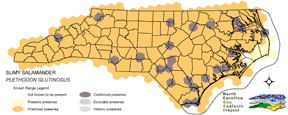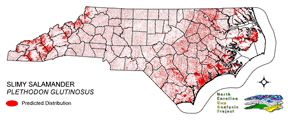
| Taxa: |
| Order: |
| Family: |
| Amphibia |
| Caudata |
| Plethodontidae |
| NatureServe Global Rank: |
| NatureServe State (NC) Rank: |
| G5 |
| S5 |
| Federal Status: |
| NC State Status: |
| --- |
| --- |


| Land Unit |
| US Fish & Wildlife Service |
| US Forest Service |
| US National Park Service |
| US Department of Defense |
| NC State Parks |
| NC University System |
| NC Wildlife Res. Com. |
| NC Forest Service |
| NC Div. of Coastal Mgmt. |
| Local Governments |
| Non-Governmental Org. |
| Other Public Lands |
| Private Lands |
| GAP Status 1-2 |
| All Protected Lands |
| Statewide |
| Hectares |
| 72,105.57 |
| 215,533.53 |
| 58,966.83 |
| 61,767.63 |
| 11,728.98 |
| 20,305.26 |
| 59,182.74 |
| 8,429.97 |
| 3,783.33 |
| 5,380.65 |
| 13,921.47 |
| 1,084.32 |
| 2,420,115.75 |
| 243,469.02 |
| 530,626.53 |
| 2,952,306.03 |
| Acres |
| 178,176.71 |
| 532,594.85 |
| 145,710.18 |
| 152,631.11 |
| 28,982.94 |
| 50,175.38 |
| 146,243.71 |
| 21,569.40 |
| 9,348.81 |
| 13,295.87 |
| 34,400.69 |
| 2,679.41 |
| 5,980,235.09 |
| 602,363.43 |
| 1,311,944.95 |
| 7,296,044.16 |
| % of Dist. on |
| Prot. Lands |
| 13.6 % |
| 40.6 % |
| 11.0 % |
| 11.6 % |
| 2.2 % |
| 3.8 % |
| 11.1 % |
| 1.6 % |
| 0.7 % |
| 2.6 % |
| 2.6 % |
| 0.1 % |
| < 0.1 % |
| 45.9 % |
| ----- |
| ----- |
| % of Dist. on |
| All Lands |
| 2.4 % |
| 7.3 % |
| 2.0 % |
| 2.1 % |
| 0.4 % |
| 0.7 % |
| 2.0 % |
| 0.3 % |
| 0.1 % |
| 0.2 % |
| 0.5 % |
| < 0.1 % |
| 82.0 % |
| 8.2 % |
| ----- |
| ----- |
|
These salamanders are common to abundant in all regions of the state (Martof et al. 1980). Slimy salamanders are found in most mesic wooded situations in both upland and lowland areas, with the exception of high elevation coniferous spruce-fir forests in the mountains (King 1939, Martof et al. 1980). Hardwood forests appear to be preferred, but can be found in pinelands, particularly in wet-mesic to near hydric situations (Petranka 1998). They are uncommon in frequently flooded bottomlands (Martof et al. 1980), however, can be common to abundant in mesic to near hydric bottomland situations that are not regularly flooded (Petranka 1998). Even when in pine forest, this salamander appears to prefer shelter under hardwood logs and stumps (Wilson 1995). NATURE SERVE GLOBAL HABITAT COMMENTS: Wooded slopes, ravines, floodplains, shalebanks, and cave entrances; most often in hardwood forest, sometimes in pinelands. Generally under or in rotting logs, stumps, or leaf litter, or under rocks, during the day. Goes underground during dry or freezing weather. Eggs are laid in rotting logs, underground, or in rock crevices. |
| Code | Name | Description | NC Natural Heritage Program Equivalent |
| 121 | Maritime Pinelands | Loblolly forests and woodlands of the outer coastal plain. | Estuarine Fringe Loblolly Pine Forest |
| 17 | Maritime Forests and Hammocks | Maritime forests and woodlands dominated by live or sand laurel oak. Estuarine Fringe forests dominated by loblolly pine. | Coastal Fringe Evergreen Forest, Maritime Deciduous Forest, Maritime Deciduous Forest |
| 50 | Coastal Plain Mixed Bottomland Forests | Includes forests dominated by a variety of hardwood species, including sweetgum, cottonwood, red maple. | Coastal Plain Bottomland Hardwood (in part), Coastal Plain Levee Forest |
| 49 | Coastal Plain Oak Bottomland Forest | Bottomland forests dominated by deciduous oak alliances. Oaks represented can include swamp chestnut, cherrybark, willow, and/or overcup oak. Inclusions of loblolly pine temporarily flooded forests occur in patches. Hydrology is temporarily to seasonally flooded. | Coastal Plain Bottomland Hardwoods (in part) blackwater subtype, brownwater subtype |
| 41 | Peatland Atlantic White-Cedar Forest | Dense stands of Atlantic white cedar with saturated hydrology. Can include swamp tupelo, red maple, and pond pines with a moderate shrub and herb layer. | Peatland Atlantic White-Cedar Forest |
| 15 | Seepage and Streamhead Swamps | Includes extensive peat flats in the coastal plain, dominated by swamp tupelo, maples, and Atlantic white cedar alliances. In the sandhills includes streamhead pond pine and bay forests alliances. Saturated hydrology. | Bay Forest, Small Depression Pocosin, Streamhead Atlantic White Cedar Forest, Streamhead Pocosins |
| 385 | Oak Bottomland Forest and Swamp Forest | The swamp chestnut oak, cherrybark oak, shumard oak and sweetgum alliance is one representative. Other alliances are dominated by water, willow, and overcup oaks. Swamp forests can be dominated by sweetgum, red maple, and black gum being dominant. Loblolly can occur in combination with sweetgum and red maple, or with tulip poplar. Includes saturated and semi- to permanently flooded forests in the mountains. | Piedmont/Mountain Bottomland Forest, Piedmont/Mountain Swamp Forest |
| 63 | Coastal Plain Mesic Hardwood Forests | Beech dominated forests with white oak and northern red oak as possible co-dominants. Dry-mesic to mesic forests on slopes and small stream bottoms in the coastal plain. | Mesic Mixed Hardwood Forest, Basic Mesic Forests |
| 138 | Coastal Plain Dry to Dry-Mesic Oak Forests | Oak dominated forests of the coastal plain. Includes white oak forests with water oak or northern red oak and hickories as co-dominants. | Dry Mesic Oak Hickory Forest, Basic Oak Hickory Forest, Dry Oak Hickory Forest |
| 87 | Pocosin Woodlands and Shrublands | Includes pond pine woodland, low pocosin and high pocosin shrub dominated areas. Canebrakes and bay forests may be present. | Pond Pine Woodlands, Peatland Canebrake, Small Depression Pocosin |
| 67 | Wet Longleaf or Slash Pine Savanna | Wet flatwoods and pine savannas, typically dominated by longleaf pines, but slash or pond pines may be the dominant pines. | Wet Pine Flatwoods |
| 97 | Mesic Longleaf Pine | Longleaf pine woodlands without a major scrub oak component. Slash or loblolly pines may be present as well. | Mesic Pine Flatwoods |
| 230 | Piedmont Mesic Forest | American Beech - Red Oak - White Oak Forests. | Mesic Mixed Hardwood |
| 384 | Piedmont/Mountain Mixed Bottomland Hardwood Forests | Includes temporarily to seasonally forests dominated by hardwood species. Hardwoods include sweetgum, red maple, sycamore which co-occur in a mosaic of bottomland and levee positions. Includes alluvial hardwood forests in the mountains. Hemlock and white pine may occur as inclusions, but are generally mapped separately. | Piedmont/Mountain Alluvial Forest, Piedmont/Mountain Levee Forest |
| 383 | Piedmont Mixed Successional Forest | Generally loblolly mixed with successional hardwoods. Sweetgum, tulip poplar and red maple are common co-dominants in these successional forests. | No equivalent |
| 51 | Deciduous Cultivated Plantation | Planted deciduous trees. Includes sweetgum and sycamore plantations. | No equivalent |
| 36 | Successional Deciduous Forests | Regenerating deciduous trees with a shrub stature. Commonly dominated by sweetgum, tulip poplars and maples. | No equivalent |
| 522 | Northern Hardwoods | High Elevation forests including yellow birch, American beech, and yellow buckeye. Includes forests with Hemlock and Yellow Birch. | Northern Hardwoods Forest, Boulderfield Forest |
| 525 | Appalachian Oak Forest | A variety of oak forest types including Black, White, Scarlet Oaks in dry to mesic situations. Includes forests historically co-dominated by American Chestnut. | High Elevation Red Oak Forest, Montane White Oak Forest |
| 526 | Appalachian Cove Forest | Mixed Mesophytic forests of the mountains. Includes tuliptree, basswood, yellow buckeye and surgar maple. This class is mapped to include cove forests dominated or co-dominated by hemlock. | Rich Cove Forest, Acidic Cove Forest |
| 527 | Appalachian Hemlock | Upland hemlock forests of the moutains region. Vary from side slopes to steep slope positions. | Canada Hemlock Forest |
|
Hairston, N. G., Sr., and R. H. Wiley. 1993. No decline in salamander (Amphibia:Caudata) populations:a twenty-year study in the southern Aplachians. Brimleyana 18:59-64.
Petranka, J. W., M. E. Eldridge, and K. E. Haley. 1993. Effects of timber harvesting on southern Appalachian salamanders. Conservation Biology 7(2):363-370. Carr, D. E. 1996. Morphological variation among species and populations of salamanders in the PLETHODON GLUTINOSUS complex. Herpetologica 52:56-65. Hairston, N. G., Sr., et al. 1992. The dynamics of two hybrid zones in Appalachian salamanders of the genus PLETHODON. Evolution 46:930-938. Wilson, L. A. 1995. The Land Manager's Guide to the amphibians and reptiles of the South. Chapel Hill, NC: The Nature Conservancy. Petranka, J. W. 1998. Salamanders of the United States and Canada. Washington DC: Smithsonian Inst. Press. Highton, R., and J. R. MacGregor. 1983. PLETHODON KENTUCKIMittleman:a valid species of Cumberland Plateau woodland salamander. Herpetologica 39:189-200. Highton, R. 1983. A new species of woodland salamanders ofthe PLETHODON GLUTINOSUS group from the southern Appalachian Mountains. Brimleyana 9:1-20. Smith, P. W. 1961. The amphibians and reptiles of Illinois. Illinois Natural History Survey 28:1-298. Frost, D. R., and D. M. Hillis. 1990. Species in concept and practice:herpetological applications. Herpetologica 46:87-104. Barbour, R. W. 1971. Amphibians and reptiles of Kentucky. Univ. Press of Kentucky, Lexington. x + 334 pp. Minton, S. A., Jr. 1972. Amphibians and reptiles of Indiana. Indiana Academy Science Monographs 3. v + 346 pp. Johnson, T. R. 1977. The amphibians of Missouri. Univ. Kansas Mus. Nat. Hist., Pub. Ed. Ser. 6. ix + 134 pp. Martof, B. S., W. M. Palmer, J. R. Bailey, and J. R. Harrison, III. 1980. Amphibians and reptiles of the Carolinas and Virginia. University of North Carolina Press, Chapel Hill, North Carolina. 264 pp. DeGraaf, R. M., and D. D. Rudis. 1983. Amphibians and reptiles of New England. Habitats and natural history. Univ. Massachusetts Press. vii + 83 pp. Green, N. B., and T. K. Pauley. 1987. Amphibians and reptiles in West Virginia. University of Pittsburg Press, Pittsburg, Pennsylvania. xi + 241 pp. Highton, R. 1987. PLETHODON TEYAHALEE. Cat. Am. Amph. Rep. 401.1-401.2. Highton, R., G. C. Maha, and L. R. Maxson. 1989. Biochemical evolution in the slimy salamanders of the PLETHODON GLUTINOSUS complex in the eastern United States. Illinois Biological Monographs 57:1-153. |
For more information please contact them at:
NC-GAP Analysis Project
Dept. of Zoology, NCSU
Campus Box 7617
Raleigh, NC 27695-7617
(919) 513-2853
www.basic.ncsu.edu/ncgap